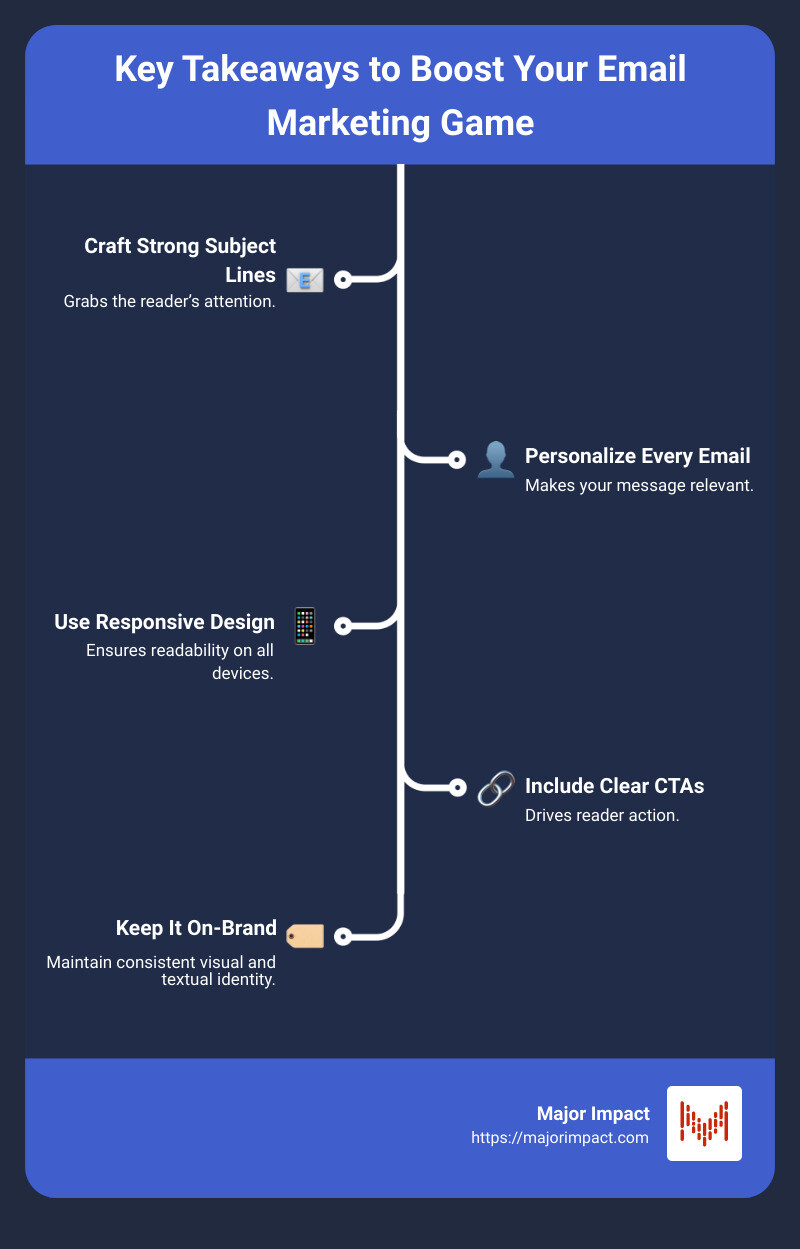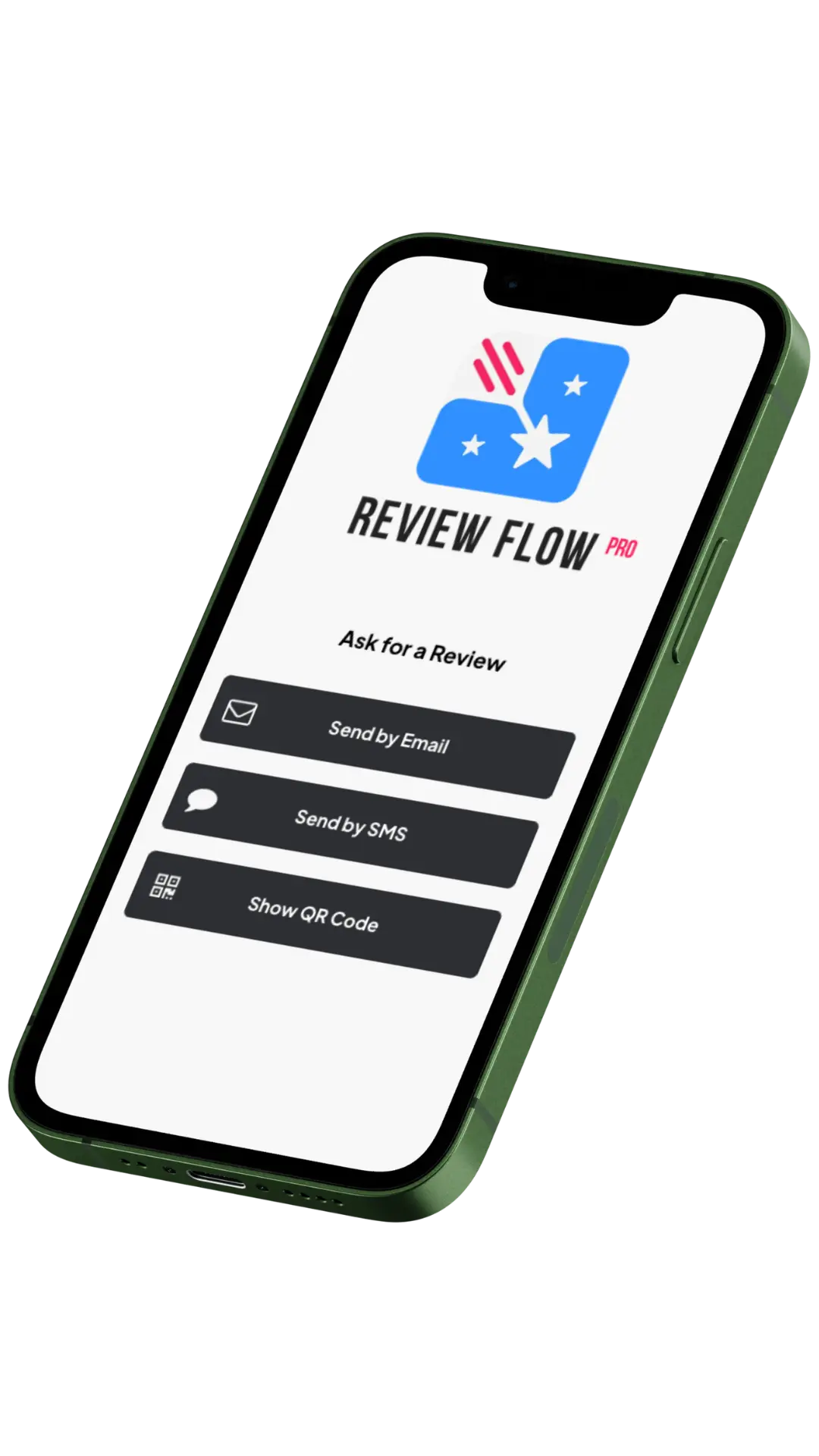Table of Contents
If you’re searching for email marketing design best practices, you’re in the right place. Here are some key takeaways to boost your email marketing game:
- Craft Strong Subject Lines: Grabs the reader’s attention.
- Personalize Every Email: Makes your message relevant.
- Use Responsive Design: Ensures readability on all devices.
- Include Clear CTAs: Drives reader action.
- Keep It On-Brand: Maintain consistent visual and textual identity.
Email design is a crucial component of any successful email marketing strategy. Even the best-crafted message can fall flat if it’s cluttered or hard to read. As email users near 4.7 billion by 2026, designing engaging, on-brand, and visually stunning emails has never been more vital.
I’m Elliott Kosmicki, a seasoned expert in email marketing and design best practices. My experience in generating leads and leading marketing teams makes me passionate about helping small businesses compete effectively. In this guide, I’ll provide actionable insights to improve your email campaigns.
Let’s dive in to understand how to create captivating emails that drive results.
The Basics of Email Design
Creating effective emails requires a blend of compelling copy, attractive design, and strategic calls to action (CTAs). Let’s break down these elements to help you craft emails that stand out and inspire action.
Copy
Your email copy is the backbone of your message. It should be clear, concise, and engaging. Here are some tips:
- Headlines and Subheadings: Use larger, bold text to break up your content. This helps readers quickly scan and understand the main points.
- Digestible Chunks: Break your text into smaller paragraphs. This makes it easier to read, especially on mobile devices.
- Personalization: Use the recipient’s name and tailor the content to their interests. Personalized emails are opened 26% more often.
Design
A well-designed email can significantly increase engagement. Here are some design best practices:
- White Space: Don’t overcrowd your email. Use white space to make your content feel less overwhelming and to highlight important elements.
- Images: Use web-optimized images (no wider than 800 pixels) to ensure quick loading times. Include descriptive alt text in case images don’t load.
- Layouts: Consider using multi-column or hybrid layouts to organize your content logically. This creates a visual hierarchy that guides the reader’s eye.
CTAs
Your calls to action are crucial for driving engagement. Here’s how to make them effective:
- Placement: Place your main CTA above the fold to ensure it’s seen immediately.
- Clarity: Use clear, action-oriented language like “Shop Now” or “Learn More.”
- Design: Make your CTA buttons stand out with contrasting colors and ample white space around them.
Email Strategy
A solid email strategy ties everything together. Here are some key points:
- Segmentation: Divide your email list into segments based on customer behavior or demographics. This allows you to send more targeted and relevant emails.
- A/B Testing: Test different elements of your emails, like subject lines and CTAs, to see what resonates best with your audience.
- Analytics: Monitor metrics such as open rates, click-through rates, and conversions to understand what’s working and where you can improve.
By focusing on these basics—copy, design, CTAs, and strategy—you can create emails that not only look great but also drive action.
Next, we’ll explore email marketing design best practices in more detail.
Email Marketing Design Best Practices
Tap into Trends
Staying updated with current design trends can make your emails more engaging. A popular trend is using a multi-column layout. This layout organizes content into two or three columns, creating a grid-like structure that’s easy to follow.
Another trend is the hybrid layout. This combines a featured story at the top with a multi-column layout at the bottom. It helps create a content hierarchy, making it clear what’s important and guiding readers to your CTAs.
Aim for Clarity and Be Concise
Your audience has limited time, so clarity and conciseness are crucial. Headlines should be bold and clear to grab attention. Break your text into digestible chunks to make it easier to read.
White space is your friend. It prevents your email from feeling cluttered and helps highlight key elements. This makes it easier for readers to focus on your message and CTAs.
Optimize for Mobile
With over 60% of emails opened on mobile devices, mobile optimization is non-negotiable. Use a responsive design that adapts to different screen sizes. This ensures your email looks great whether viewed on a phone, tablet, or desktop.
Responsive templates are available in most email marketing platforms. Use them to save time and ensure consistency. Always test your emails on multiple devices before sending them out.
Key Elements of Email Design
Create a Modular Design System
A modular design system for emails uses content blocks that can be reused across different campaigns. This approach saves you time and ensures consistency. Think of it like building with LEGO pieces—you can mix and match sections to create something new without starting from scratch each time.
Questions to consider:
– Are there sections you frequently repeat, like footers or headers?
– Do your brand guidelines specify certain colors, fonts, or spacing?
For example, Litmus uses a modular design system to build their newsletters, making it easier to maintain brand consistency and save time.
Use a Responsive Email Design
Responsive email design is crucial for ensuring your emails look great on any device. This means your layout adapts to different screen sizes using CSS media queries.
Instead of creating new designs for each device, use responsive templates. These templates automatically adjust elements like images and text blocks, making your job easier.
Pro Tip: Test your emails on multiple devices before sending them out. A simple tool like the Klaviyo template editor can help.
Maintain Overall Consistency
Consistency in email design is vital for building brand recognition. Create an email style guide that aligns with your branding guide. This ensures that every email you send looks and feels like it’s from your brand.
Elements to include in your style guide:
– Fonts and colors
– Image styles
– Button shapes and sizes
Example: Litmus keeps a consistent experience across all their emails by adhering to a well-defined style guide.
Crafting Engaging Email Copy
Accept Personalization and Dynamic Content
Personalization is a game-changer in email marketing. Emails personalized to the recipient are opened 26% more often than non-personalized ones. It can be as simple as including the customer’s name in the subject line or as complex as tailoring content based on customer data points like online behavior and purchase history.
Dynamic content takes personalization to the next level. This type of content changes based on user data, making each email feel bespoke. For example, if a customer recently bought a camera, send them tips on using it or accessories they might need.
Pro Tip: Use marketing segmentation and email automation to create dynamic content. This can save time and ensure your emails are relevant to each recipient.
Focus on One Main Call to Action
Your email should have a clear and direct Call to Action (CTA). If you need multiple CTAs, organize them in a hierarchy. The main CTA should be prominent and placed higher up in the email, with secondary CTAs coming later.
Design Tips:
– Use contrasting colors to make your CTA stand out.
– Use buttons for primary CTAs and text links for secondary ones.
– Make it clear where the reader will go when they click.
Example: A fashion retailer might use a bold button for “Shop Now” at the top and a text link for “Learn More” about a sale further down.
Craft an Enticing Subject Line
Your subject line is your first chance to grab attention. Make it compelling but not misleading. A well-crafted subject line can significantly increase your open rates.
Tips for Crafting Subject Lines:
– Create urgency: “Only 24 hours left to save!”
– Ask questions: “Ready for a summer getaway?”
– Keep it short: Aim for 50 characters or less.
– Avoid spam triggers: Words like “Free” or multiple exclamation points can send your email to the spam folder.
A/B Testing: Experiment with different subject lines to see what resonates best with your audience. For example, test a sales-oriented line against a more provocative one to find the sweet spot.
Example: A/B testing showed that “Open up Your Exclusive Discount” performed better than “Get 20% Off Now!” for an e-commerce brand.
Visual Hierarchy in Email Design
Use Compelling Visuals
Visuals are a powerful tool in email marketing. They catch the eye and support your brand. Here are some tips to make your visuals work for you:
Z-Pattern and Inverted Pyramid:
- Z-Pattern: This layout guides readers’ eyes in a Z-shape, from top left to bottom right. It’s great for getting subscribers to read all your content. Spread eye-catching elements throughout to keep interest high.
- Inverted Pyramid: Start with a broad, attention-grabbing headline, then narrow down to your main point or call-to-action (CTA). This layout helps focus the reader’s attention on what matters most.
Faux Video and GIFs:
- Faux Video: Use a static image with a play button overlay. This tricks the eye into thinking there’s a video, encouraging clicks.
- GIFs: Add personality and movement to your emails. Use them sparingly to avoid overwhelming your audience.
Background Images:
- Texture and Depth: Background images can add texture and depth to your emails. Just ensure they don’t distract from your main message.
Pay Attention to Typography and Fonts
Typography is as important as imagery. The right fonts can make your email more readable and visually appealing.
Web Safe Fonts vs. Web Fonts:
- Web Safe Fonts: These fonts are pre-installed on most devices. They’re reliable but limit your design options. Examples include Arial, Helvetica, and Times New Roman.
- Web Fonts: These are hosted on servers like Google or Adobe. They offer more design flexibility but may not render correctly on all devices. Examples include Roboto and Open Sans.
Live Text:
- Accessibility and SEO: Use live text instead of embedding text in images. This makes your emails more accessible and improves load times.
Font Tips:
- Consistency: Stick to 1-2 fonts to keep your design clean.
- Size: Use 14-16px for body text and 18-24px for headings.
- Contrast: Ensure high contrast between text and background for readability.
By using compelling visuals and paying attention to typography, you can create emails that are not only beautiful but also effective.
Next, we’ll dive into Interactive and Accessible Email Design, exploring how to make your emails not just visually appealing but also engaging and accessible to all users.
Interactive and Accessible Email Design
Use Interactive Content
Interactive elements in emails can significantly boost engagement. They create a mini-experience for the reader, encouraging them to interact without leaving the email. Here are some interactive features you can incorporate:
- Animated Buttons: These can draw attention to your CTAs. For example, a pulsating “Shop Now” button can be more enticing than a static one.
- Product Carousels: Allow users to browse through multiple products within the email itself. This is particularly useful for showcasing new collections.
- Rollover Effects: These change content when a user hovers over an image or text. For instance, an image could display product details when hovered over.
- Polls and Surveys: These can be embedded directly into the email, making it easy for recipients to provide feedback.
Case Study: Harry’s, a men’s grooming brand, used an embedded quiz in their email campaigns, which significantly increased user interaction and engagement.
Ensure Emails are Accessible
Accessibility is crucial for reaching all your audience, including those with visual impairments. Here are some ways to make your emails more accessible:
- ALT Text: Always include descriptive ALT text for images. This helps screen readers describe the images to visually impaired users. For example, instead of “image1.jpg,” use “A woman using our new skincare product.”
- Background Color: Ensure there is enough contrast between the text and background. This improves readability for everyone, especially those with visual impairments.
- Readable Fonts: Stick to simple, web-safe fonts. Avoid overly artistic fonts that might not display correctly on all devices.
- Dark Mode Compatibility: Many users prefer dark mode to reduce eye strain. Make sure your emails look good in both light and dark modes. Preview your emails on different platforms to ensure compatibility.
Fact: More than a third of email users view emails in dark mode. Optimizing your emails for dark mode can improve user experience and engagement.
Dark Mode
Dark mode is increasingly popular and can improve readability for many users. Here’s how to optimize your emails for dark mode:
- Use Transparent PNGs: This ensures that images blend well with both light and dark backgrounds.
- Avoid Pure Black: Use dark shades of gray instead. Pure black can create too much contrast, making text hard to read.
- Test Extensively: Preview your emails in dark mode on various devices and email clients to ensure they look good everywhere.
By incorporating these email marketing design best practices, you can create emails that are not only engaging but also accessible to a wider audience.
Next, we’ll discuss Crafting Engaging Email Copy, focusing on how to make your email content resonate with your audience.
Frequently Asked Questions about Email Marketing Design Best Practices
What is the importance of email design in email campaigns?
Email design is crucial for the success of your campaigns. Studies show that email users are expected to reach 4.7 billion by 2026. With so many potential readers, your email design needs to stand out.
Here’s why good design matters:
- Grabs Attention: A well-designed email captures the reader’s attention quickly. If your email is cluttered or unattractive, it may be ignored or deleted.
- Improves Readability: Clear and concise design helps readers understand your message without getting overwhelmed by too much text.
- Increases Engagement: Visual elements like images, videos, and CTAs guide readers to interact with your content, boosting click-through rates.
- Strengthens Branding: Consistent design elements like colors, fonts, and logos reinforce your brand identity, making your emails instantly recognizable.
How can I personalize my email content effectively?
Personalization goes beyond just adding the recipient’s name. Here’s how to make your emails feel more personal:
- Segment Your Audience: Divide your email list based on criteria like location, purchase history, or behavior. This allows you to send more relevant content to each group.
- Use Dynamic Content: Tools like Mailchimp and Constant Contact allow you to create emails that adapt based on user data. For example, show different product recommendations based on past purchases.
- Address Pain Points: Tailor your message to address specific problems your audience faces. Show how your product or service can solve these issues.
- Include Personal Touches: Beyond names, use information like birthdays or anniversaries to send special offers or greetings.
Nura Busleiman, head of email marketing at MarketerHire, advises, “Understanding their journey will lead you to better emails and results, of course. Your contact needs to understand why they are receiving that email at that moment and what they are expected to do.”
What are some common mistakes to avoid in email design?
Even small mistakes can impact the effectiveness of your email campaigns. Here are some common pitfalls to watch out for:
- Cluttered Layouts: Avoid overwhelming your readers with too much information. Use white space and organized layouts to make your content easy to digest.
- Lack of Clear CTAs: Make sure your call-to-action is prominent and easy to find. A clear, single CTA is more effective than multiple competing ones.
- Inconsistent Branding: Ensure your emails match your overall brand style, including colors, fonts, and tone. This helps build brand recognition and trust.
- Ignoring Mobile Optimization: Over 60% of emails are opened on mobile devices. Use responsive design to ensure your emails look great on any screen size.
- Not Testing: Always test your emails on different devices and email clients before sending. This helps catch any issues that could affect readability or functionality.
By avoiding these mistakes and following email marketing design best practices, you can create emails that not only look good but also drive action.
Next, we’ll discuss Crafting Engaging Email Copy, focusing on how to make your email content resonate with your audience.
Conclusion
Great email design makes a huge difference in your marketing efforts. By following email marketing design best practices, you can create emails that not only look good but also drive action. From crafting compelling subject lines to ensuring mobile optimization, every detail matters.
By implementing these best practices and leveraging our expertise, you’ll be well on your way to creating emails that captivate and convert.








